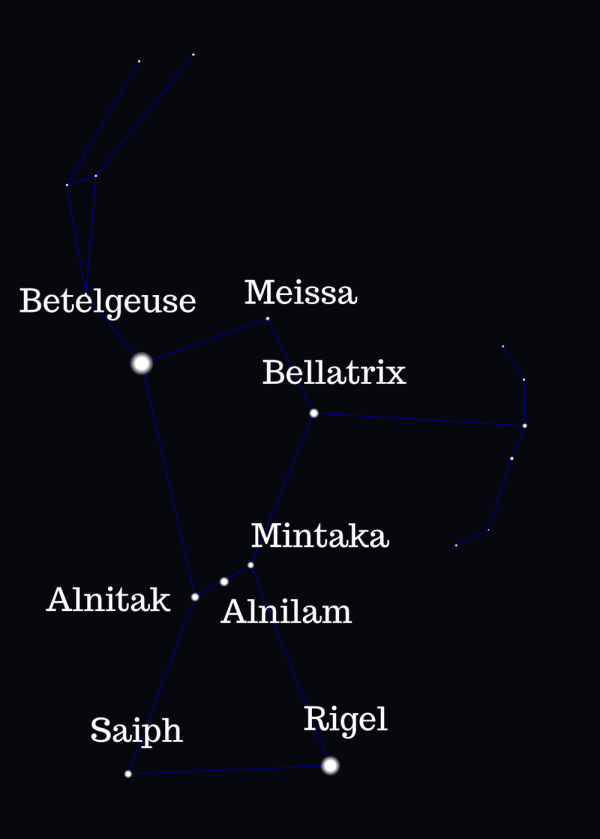In March the observers in the Northern Hemisphere are saying goodbye to our favourite winter constellation Orion. But before the Great Hunter disappears from the view until the next Autumn, let’s take a close look at the stars that make up the famous hourglass shape.
Note: we will describe Orion as we see it from the Northern Hemisphere. Observers in the Southern Hemisphere will see Orion mirrored and upside down.
Left shoulder….Betelgeuse
Alpha Orionis is commonly known as Betelgeuse, which means the “underarm of Orion” in Arabic. It is a very famous and well studied star. Betelgeuse is a Red Supergiant more then 900 times the size of our Sun. And not just any supergiant, but the closest one to the Earth. One day Alpha Orionis will explode as supernova, and when that happens, the star will be visible in the daytime for a few weeks.The Boom can happen any moment in the next million years. But don’t worry, we will be watching the spectacular show from a safe distance of about 640 light years. It will cause no harm to the Earth and its inhabitants whatsoever. Phew!
Betelgeuse is known to change its brightness over time in a complicated pattern. The stars that behave this way are called semiregular variables. Modern astronomers were not the first to discover the variability of Alpha Orionis. Researchers think that Aboriginal Australians already knew about and observed the changes in its brightness!
Although Betelgeuse is a single star, some astronomers think that it used to have a stellar companion that the star swallowed when it swelled up as a Supergiant. This could have explained the unusually fast rotation of Alpha Orionis.
Everything about Betelgeuse is a bit of a mystery: its size, distance to the Earth and even how much time it’s got left. But that’s part of what makes this star so interesting to the researchers and observers all over the World!
Right shoulder…Bellatrix
Designated Gamma Orionis, Bellatrix (meaning “female warrior” in Latin) is a single blue-white star 4 times hotter and 6 times bigger than the Sun. Scientists think that Bellatrix is aging, and possibly has already evolved into what we call a Giant star. Just like Betelgeuse, Bellatrix changes its brightness over time, so it is too classified as a variable star. Gamma Orionis is the closest of the seven famous Orion stars to the Earth.
Head…Meissa
Faint star Lambda Orionis, or Meissa, marks the head of the Great Hunter Orion. If you point a small telescope at Meissa, you will be surprised to discover that it is actually a pair of hot blue-white stars: a giant and a main sequence star. It might have had another stellar companion in the past that has already exploded as a supernova.
Left foot…Saiph
White-Blue Supergiant Saiph ( Kappa Orionis) marks Orion’s left foot. The name of the star can be loosely translated as “sword of a giant” from Arabic. Approximately the same distance from the Sun as Betelgeuse, Saiph will share the fate of other red supergiants and explode as a supernova one day. But, again, don’t panic, we will be quite safe here on Earth!
Right foot… Rigel
Another future Supernova, the Blue Supergiant Rigel, outshines all the other stars in Orion. It should have been designated Alpha Orionis, but because the variable star Betelgeuse happened to be at its brightest at the time the stars were cataloged, Rigel got only a second “Beta” place. Although invisible to the unaided eye, Rigel has three companions, making Beta Orionis a quadruple star system.
Orion’s Belt
Orion is very easy to find on the sky thanks to the three stars, Alnitak, Alnilam and Mintaka, that form “Orion’s belt”. The stars appear to be about the same size and distance from each other and make a nearly straight line. Some people believe that the three stars in the Belt align with the three main pyramids in Giza. But the arguments against this so-called Orion correlation theory (though it does sound absolutely beautiful) look quite strong.
Alnitak (left)
For the past few centuries observers knew that what looks like a star marking the left side of the Hunter’s belt is actually a binary system: a blue supergiant with its smaller blue companion. But more recent observations revealed another blue subgiant located close to the primary star. It turns out that Alnitak (designated Zeta Orionis) is a triple star system.
Alnilam (middle)
The brightest star in the Belt and the most distant one is Epsilon Orionis, or Alnilam. This hot and luminous blue supergiant is over 30 times as as big as the Sun. Just like any other star of this kind, Alnilam will one day turn into red supergiant and eventually explode as supernova.
Mintaka (right)
Another example of a multiple star system is a Blue Supergiant Mintaka (aka Delta Orionis). The star system consists of a main triple star component (two very hot stars orbiting close together and the third star further away) and one or two single stars (researchers are not sure whether one of the stars is part of Mintaka system or a background star).
Still curious?
- Visit our pop-up planetarium to learn more about the night sky, constellations, famous stars and other amazing celestial objects.
- Send your questions and comments to our star dome team. We would love to hear from you!
- Read more astronomy news in our space blog.
Happy stargazing!

